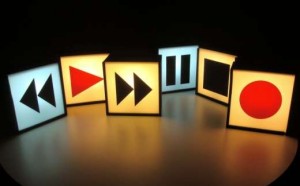One way to define love is "sustained, compassionate attention". These words came from John Muir Laws, a naturalist, educator, and artist who inspires stewardship of the land by sharing his practice of nature sketching. When I read these words, I began to see the importance of my own art practice in developing sustained, compassionate attention for myself.
Read moreBe Willing to Drop the F Bomb
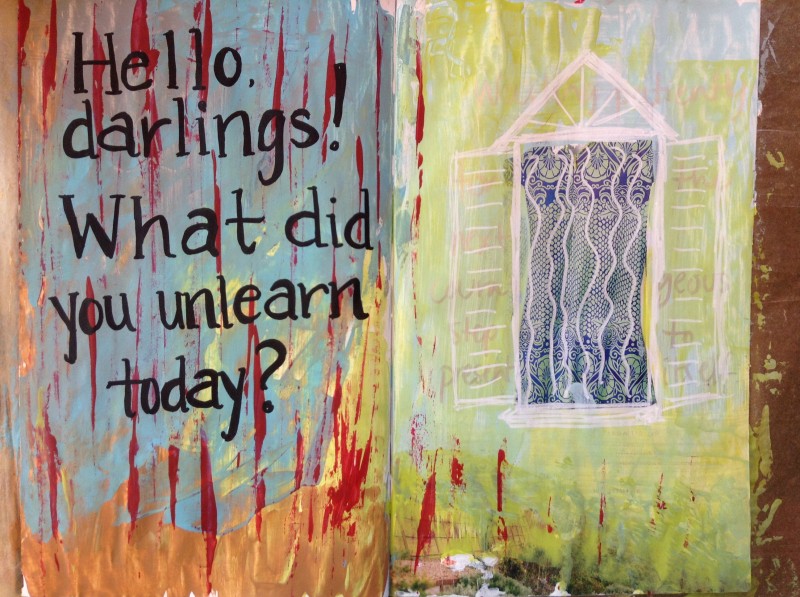 When I was a senior in high school applying to college, I remember one university had as its essay question, "What was your biggest failure and what did you learn from it?". I remember considering not applying to that school because I couldn't think of a failure to write about.
When I was a senior in high school applying to college, I remember one university had as its essay question, "What was your biggest failure and what did you learn from it?". I remember considering not applying to that school because I couldn't think of a failure to write about.
At the time, I was on the receiving end of a lot of attention and praise for never having failed (publicly at least). But now as an adult, I know the trap of living a life based on avoidance of failure. It's no success to have reached all the goals that have been set for you, to have checked all the boxes other people have laid out as important for you, and then to look in the mirror and not recognize yourself. Or to have your body screaming in pain or exhaustion.
Having been there and done that, I have rediscovered the vital importance of failure. Not "achieving" failure as an identity, but being willing to fail. I gave a workshop on Friday to a group of engineers, coaches, consultants, startup founders, and other change agents interested in how groups of people grow and learn. It was based entirely around sound, voice, and music improvisation - in other words, the most common fears of about ninety-nine percent of the population.
The name of the workshop was, "Play the Wrong Note: Daring Adventures in Learning, Failure, and Creativity". The title actually refers to a specific moment in my life when everything changed for me. Those four words - "Play the wrong note" - were the four most compassionate words ever spoken to me by a teacher. No one in a position of authority had ever said, "Lisa, I want to see you break the rules. And I'll help you." It turned out to be the most loving instructions I ever received, and the framework for an entire body of work.
It was about three months in to my sound healing training program. A weekend workshop dedicated to the art of improvisation. I thought I could just observe and let the others do this improvisation thing, which was clearly for "those people" but not me. So I hid behind the teacher with my violin tucked under my arm, hoping he would not see me or ask me to participate in this bluesy, jazzy jam that was happening all around me.
And, of course, at that very moment, he turned around and pointed right at me. "You! Solo!" he said.
I had no idea what to play. I wasn't into blues or jazz and had no reference point for what sounds to make. He could sense that I needed help so he said, "Play the wrong note."
My facial expression must have communicated the feeling I had, which was, "OK. But...which one?". There were an infinite number of wrong notes I could play. How would I know which one was right?
He smiled and took my finger in his hand, and moved it to a random place on the fingerboard of my violin. "Play that," he said gently.
I heard his instructions, but when I tried to play, my bow arm literally would not move. I was so hard-wired to play only the right notes - after daily practicing from age four - that my entire body would not allow me to play any wrong ones.
It was the perfect timing for me. I was ready. I had had a lifetime of good training, practice, and mastery. I was wired for success. But I had no wiring for freedom, fun, or failure. And in that moment, standing there, stranded, in the middle of a room with forty or so people making sounds, having a great time, and waiting for me to solo, I got it.
I could continue to avoid failure, or I could choose to grow into the unknown.
Later that day, in the same workshop, my violin case fell off its chair and onto the floor.
I took it as a sign and stopped avoiding the failures that were wanting to happen for me. I closed my violin school a little over a month later. I started practicing - first in the privacy of my own home, and using my voice, not my violin - making sounds that were all "wrong" to my trained ears. I started PLAYING again. Something I had not done in a long time, and maybe never on my violin.
The adventure that followed was a list of things I could never have planned for my life. I started playing only improvised music, in public, on a stage. I discovered hiking and backpacking. I went to the top of Half Dome and the bottom of the Grand Canyon. I started working at REI - the retail job I was never allowed to have as a teenager because I could earn more money teaching violin or staying home to practice. I won a gig as a gear tester and reporter for Backpacker Magazine, including a free trip to the Outdoor Retailer show in Salt Lake City. I discovered Thai massage and Breema bodywork, which led to traveling to three countries I would never have dreamed of visiting before - Bali, Thailand and Laos. And through my practice of these forms of bodywork, I traded massages for studio days with a couple of artist friends. And I discovered that I could play with paint. Which led to a daily art-making habit. Which has (so far, in the year or so that I've been doing it) led to a juried show, a new blog, and a whole lotta new art supplies in my house.
I could not have written these down on a bucket list because I would never have let my imagination run that wild. Until I was willing to Play The Wrong Note.
And not just once, in a workshop. It was about making a decision to bring the learning from that moment back to my daily life. To find ways to practice that willingness every time the opportunity came up.
It started with music. Being willing to play the wrong note in my personal comfort zone. And then it expanded. Not with planning but as a natural consequence of becoming familiar with the willingness to be "wrong".
So this is my soapbox.
Risk taking is necessary. Being open and willing to fail is necessary. Not knowing is necessary. And these skills are not taught in school. They are not the skills that get you straight A's. They are not the skills that make you look "smart". They are not the skills that earn you the proud distinction of being a Good Daughter (or Wife or Mother). They are not the skills that you use to fill out a college or medical school application. They are often not the stuff of polite cocktail party conversation.
They are the skills of the maverick. The rebel. The free thinker. The one who creates.
So no matter how long ago it was that you experienced your last failure - whether it was just this morning or decades ago or not at all - it is never too late to dive right in. Start practicing the F word.
Take it from a straight A student. Me.
Curious about my "Play The Wrong Note" workshop? Read this blog post or listen to the Creative Conversation we had yesterday about it.
And if you're ready to start practicing Fun, Freedom, and Failure with writing as improvisation, check out my brand new coaching program here.
Wishing You The Fun and Freedom of Being Willing to Fail,
Lisa
Surrender and Loving It 'Til You Know What It Is
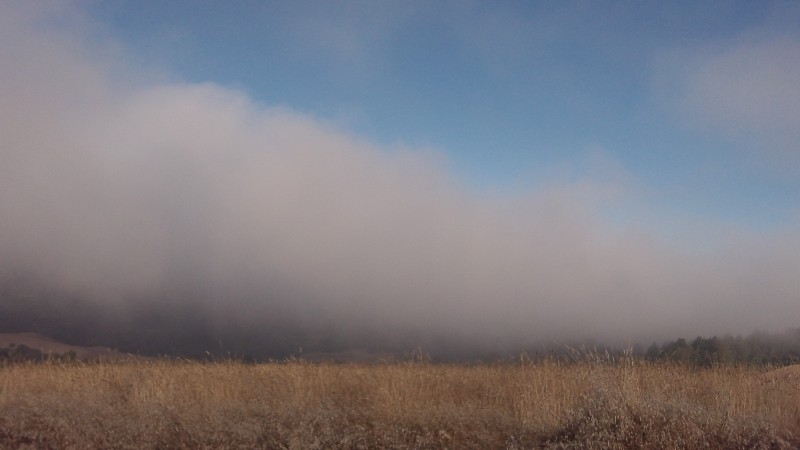 I am in a large group of women artists who have driven up to the ridge of a mountain range and then down a very windy road to a secluded artists retreat program in northern California. All I want to do is stare at the dreamy landscape, watching how the golden green hills go back and back and back, disappearing finally into a fog bank which hovers just above the sea in the distance. I want to watch as the wind blows, the fog clears, and the misty outlines of the hilltops begin to glisten in the midday sunlight. I want to sit and sketch it, and fill in the colors I am seeing, and try to capture the dreaminess, the haziness of it all, the lack of precise outlines which gives it that quality of mystery that makes me want to keep staring.
I am in a large group of women artists who have driven up to the ridge of a mountain range and then down a very windy road to a secluded artists retreat program in northern California. All I want to do is stare at the dreamy landscape, watching how the golden green hills go back and back and back, disappearing finally into a fog bank which hovers just above the sea in the distance. I want to watch as the wind blows, the fog clears, and the misty outlines of the hilltops begin to glisten in the midday sunlight. I want to sit and sketch it, and fill in the colors I am seeing, and try to capture the dreaminess, the haziness of it all, the lack of precise outlines which gives it that quality of mystery that makes me want to keep staring.
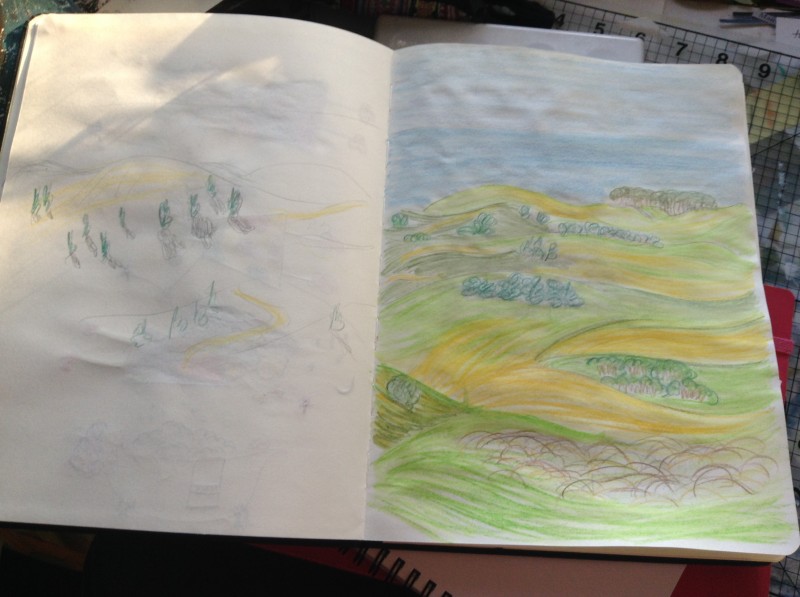
But we have a schedule. There are ranchers and herders moving us along in this schedule, ensuring that we are on time. I help myself to a large lunch - two servings each of lentil soup and kale salad with some fruit on the side. My idea of a perfect meal. But my stomach feels slightly full after all that, and I am ready to rest and digest.
Having forgotten the schedule momentarily, I’m jarred when it is announced that we now need to move into another room for a “movement activity”.
I take my time walking there, hoping those extra few seconds will give my digestive system time to bring the food down a little more.
By the time I join, the circle has been formed and all the women are bouncing lightly on their bare or socked feet. This being one of only 14% of artist residency programs in the country who have a fully spring loaded dance floor, shoes are not allowed.
Ann Swanberg is the leader. I had experienced her work once before in a large church, where she presented her improvisational approach to life in a humorous show. We kept bouncing - this was Ann’s method for keeping us out of our thinking minds and in some other realm governed by the moving, breathing body - and we did a whole host of games designed to get us to drop our personalities by acting silly and free.
What I noticed is that my recent experiences with becoming present were done in the stillness and silent meditative movement of the Breema Center. Somehow in that setting, where I was truly not a personality and there was absolutely no imperative to show up as entertaining in any way, I could feel my own bodily presence. In this setting where everyone was asked to do something silly, there was slight pressure to be “silly enough”. As if stillness would not have been accepted there. But I don’t know because I just flowed with the energy of the room.
One of the more silent and inward-turning exercises of the day did capture my attention. She called it “The Infinity Box” or “Loving It ‘Til You Know What It Is”. The instructions went something like this: Reaching into an imaginary box from which anything is possible, allowing the “Body First” to lead the improvisation, follow the shape your hands spontaneously take as you reach in. As they emerge from the imaginary box, just be with them. Don’t change them or manipulate them into what you think they might be. Just breathe with the shape, feel it.
"Love it ’til you know what it is."
It was fascinating to watch the different shapes my hands took on when I allowed them to. Fingers apart and curved, palms facing up. Fingers together, joined at the thumbs and index fingers. Palms cupped, joined together, facing up. And then waiting. Breathing. Feeling. An answer or image always emerged. But sometimes I had to stay with it longer than expected. The final one I ran out of time on. So I sketched it, and it is permanently imprinted in my bodily memory. I am still wondering what it is.
It reminded me of painting. How the creative practice for me is staying with something long enough to find out what it is. Not to give up. Not to decide in advance that something’s “never going to work”. So often when I have mustered the courage or audacity or love to stay with it, to keep going, to keep loving it, something else so beautiful and magical emerges right on top of it all.
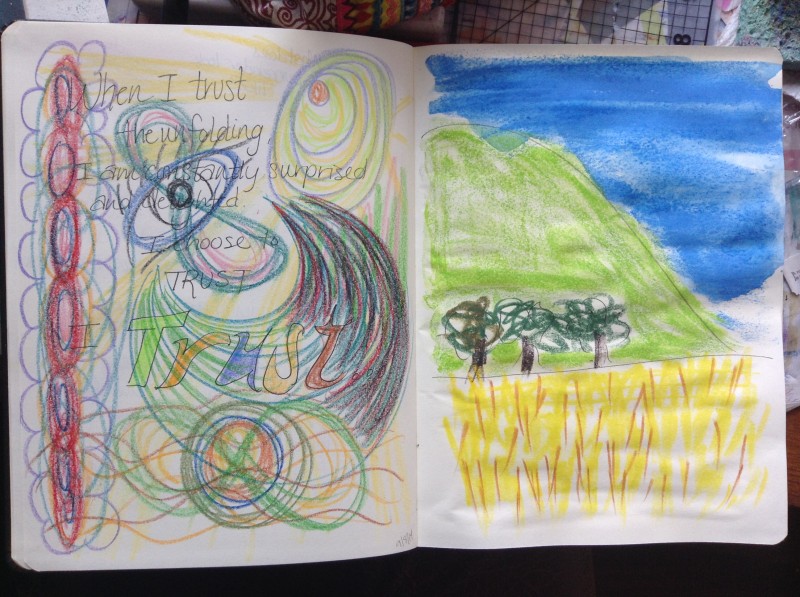
Chris Zydel sent out her newsletter yesterday too, and I happened to read all the way to the bottom. The article was about "Surrender". How surrender is not giving up or weakness or defeat. But rather a form of full presence. That in order to fully participate, there is surrender involved. As I write this, it occurs to me that the four “No…” principles from Breema touch on what kinds of surrender are involved - No Judgment, No Force, No Extra, No Hurry No Pause. Well that’s a lot to give up in order to get to presence! How often are we drowning in judgment, doing more than is needed, rushing around, or not acting because we feel stuck in hesitation.
Surrender is the sweetness of letting life lead. Of loving whatever life gives you until you know what it is. I am attempting to apply it to my body, my relationships, my work decisions, all of which I apply a certain amount of control, changing, and fixing to. I don’t really know the state of full surrender into acceptance. I am pointing towards it sometimes, but I haven’t sunk to the depths of that pool to say, “Huh. So this is it. I’d like to know how this feels. Really.”
Here’s what Chris had to say about surrender:
When a sunflower turns its face to follow the sun, that is surrender. When a seed planted in a rich soil breaks free of its encasement and pushes its way up to the light of day, that is surrender. When a wild mustang gallops wildly and joyfully across a meadow, that is surrender. When a baby tries to grasp a beam of light, laughing delightedly, that is surrender. When you look at a sunset and feel the peace of simply breathing in and out, that is surrender. When you enjoy a delicious meal, letting the flavors tickle your tongue, that is surrender. When you feel drowsy and begin to fall asleep, that is surrender.
In all these experiences you, or the horse or the sunflower are completely giving into what's right there in front of you. You are simply being in the present moment with what you feel drawn to do.
So in other words, surrender is something that happens daily, hourly, minute by minute in our lives. It's so very common and down-to-earth. It's in the most intimate fabric of our existence. And includes everything from the mundane to the ecstatic.
And tomorrow, with the start of the final Energy Gardeners' Club of the year, I am ready to apply the principle of Surrender. Making things happen is not about controlling in order to get what you want. Making is allowing.
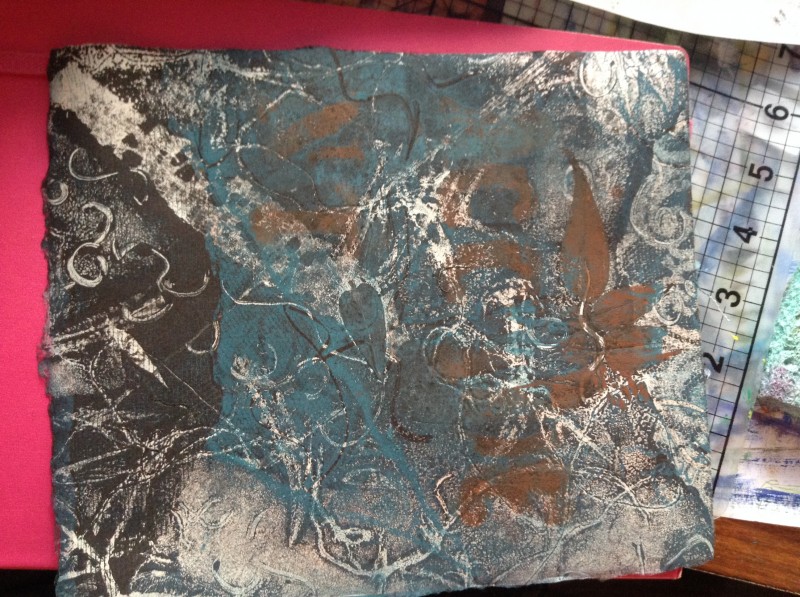
Learning to Ride
It’s freezing. All I know is it’s 11 miles out and back. The description on the website had said, “Participants must be in good cardiovascular condition. No single track/technical work. Climbing for sure.” I should have known when I saw the fat tires on everyone else’s bikes.
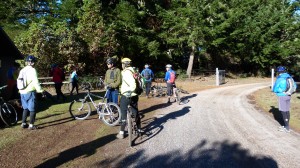
Oh, how we wish that learning would take place in the comfort of our familiar homes! A cozy blanket, a warm cup of tea, our favorite music playing, and the knowing that everything as we have chosen and arranged it now surrounds us.
Learning for me always looked like showing up in a classroom, or privately in front of a teacher, and demonstrating what I knew. I would then get feedback in the form of a critique, the next challenge chosen by the teacher, or a score on a test that told me how much what I thought I learned matched what I was expected to have learned.
What I learned on my first mountain bike ride this weekend is that learning – the fresh, raw experience of aha!wow! that’s new! – can be extremely uncomfortable. It can happen when we are placed (or we find ourselves) in a situation we did not know we chose (but we did) and that every fiber of our being is wanting to fix, alter, escape, or resist. But there we are. In my case, “there” was a guided 11-mile ride on a closed access trail. Turning back was not an option without taking the entire group with me.
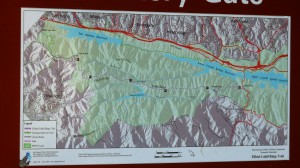
There are questions, but none worth asking, because any answer provided verbally in advance would not actually provide helpful information. I could only get answers in the act of experiencing it. How steep are the hills? How will my bike hold up? Am I dressed warmly enough? What gears should I use? Am I in good enough shape for this?

I find out the answers to each of them as I encounter the first climb, and then the first big downhill. The first of many. Each one a little longer, a little steeper. They keep coming. My lungs are burning. My ears are burning from the freezing cold air. I am miserable, I am cursing my bike for not being a “mountain” bike, only a hybrid. I excuse myself from having to keep up with the group because of this. I don’t want anyone to talk to me. I just want to breathe without the burning in my lungs.
At one point I am hurtling down a steep hill. My tires slip a little, causing me to bounce and weave, and instead of trying to take control, I decide to just let the bike do its job. I had no ability – defined as knowledge through experience – to control the bike or determine whether I would even stay on it. Slamming on (or squeezing) the brakes was not going to guarantee any safe outcome. I briefly flash back to skiing, where I’d always tried to slow myself down at the steepest parts, and it wasn’t always the best way – it was resisting the flow down the mountain, and it took a lot of effort to go against gravity.
I see now that I was lucky not to have fallen. But in that moment I had no concept of “luck” or “no luck”. It just wasn’t my day to fall. I let go, and it was my day to witness that miracle.
I keep going only because no one really asks me if I want to stop. I cycle through struggle, resistance, surrender, and then surviving.
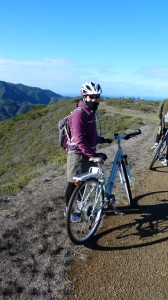
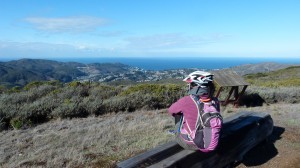
I take a rest, at the turnaround point, and just breathe. It feels good to cover my entire face and breathe normally. Now I really have no choice other than to go back along the trail the same way we came.
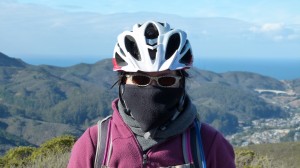
I become curious, and begin to play. That’s when the true experience of learning begins to happen.
What could I try to do differently to see if it will make my experience any different?
I stop telling myself I have the “wrong” bike and start playing with adjustments. I raise the seat up. That one small move helps a lot.
My mind so wants a binary “how to” on the gears. A set of instructions like, “When going downhill, do this….When going uphill, do that.” But it isn’t that linear. Every hill is slightly different. My ingoing speed determines which gear would match it best when coming out of the hill. I have to play. Constantly engage with what is happening in this very moment, and be open to discovering.
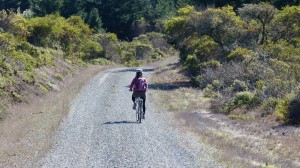
I discover an elaborate, moment-to-moment dance of body, bike, and terrain. Tweaking. Feeling. Being ever present and also facing forward, constantly moving. Listening. Discovering. Adjusting by taking small actions.
During the second half of the ride I am much more friendly with my bike, my body, and the terrain. I am much more involved as a full participant, doing my part of the three-way equation, not trying to resist or control the other elements. I am having (slightly) more fun along the way.
At the end, I feel tired but glad. My body is very grateful for the opportunity to play and be worked. Discovering new possibilities and dancing within the situation, I realized there was only the choice of the moment – to ride it or to stew in a story of misery. I chose to ride.
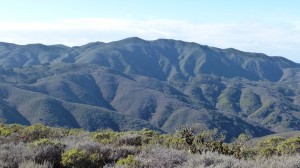
E-Squared Book Club: Week 5
This week we discussed Experiments #6 (The Superhero Principle) and #7 (The Jenny Craig Principle). Both principles relate to the ability of our thoughts to impact physical matter in the material world. First we discussed the results of the seed experiment. As you may recall, Tammy gifted us with sunflower seeds from her studio garden, along with a little bag of soil. It was such a beautiful gift! I went home and planted my seeds that night.
As I tossed them into the soil playfully, I said, "Isn't it AMAZING that this one row of seeds is already growing faster than the other row?? I'm AMAZED!". At that point, of course, they were "just" dry seeds going into soil, sitting on my kitchen table. Nothing had happened yet. Except my thought and feeling of ALREADY being amazed at their growth.
Two days later, I was truly amazed to see sprouts beginning to show. I literally thought nothing about these seeds other than the feeling of amazement that they were already growing faster.
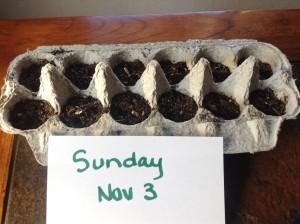
I added a few drops of water to the carton every couple of days, and regardless of what I saw with my eyes, I commented, "Isn't it AMAZING that this row of seeds is growing so much faster than the other row! I am AMAZED!". I didn't say, "I can't believe it!", or "I can't explain it!". I just held the amazement.
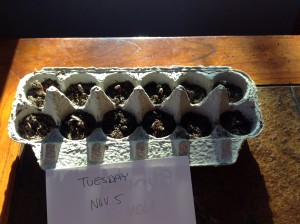
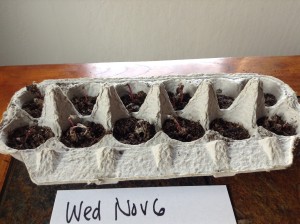
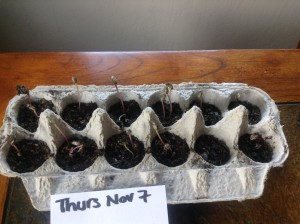
And they continue to grow and amaze me, every single day!
A couple of notes on this experiment for me: I have absolutely NO expectation about me and growing things. I'm not exactly a "green thumb" and haven't had a major draw to grow plants before. I think because of this, I was able to be truly open and playful. I had nothing to prove and everything would be a surprise for me coming from these seeds.
Tammy planted her seeds one day after mine and they had not sprouted at the time of our meeting yesterday. She had placed them with loving care in a special spot at her studio, and every day as she watered them, she waved her hand over them to transmit loving and encouraging energy to the seeds. She talked to them, using the energy of her words to support their growth.
Why were our results different?
We talked about the difference in energy between "wanting" something to happen and "believing" it is already happening. When you send an energy of "want", the result remains in the future. You receive what you asked for, which is continuous wanting. When you believe that something IS, and carry that energy regardless of the "results" you can see with your eyes right now, you support the essence of life that wants to thrive, grow, and come into being.
We demonstrated this with the Push Together-Pull Apart experiment, which I learned from my life coaching mentor, Martha Beck. It goes like this (and is discussed in Martha's latest book, Finding Your Way in a Wild New World):
1. Have a partner stand with their arms bent, hands in front of their body, with palms facing in (as if they are about to clap).
2. Tell them not to let you push their hands together, as you press on the tops of their hands as hard as you can. Fill your thoughts with effort, pushing, and domination as you do this.
3. Now, do the same thing, except this time hold in your mind thoughts of joy and love, or a time in your life when you felt utterly at peace. Don't think about the other person, just hold these thoughts and allow them to spread throughout your entire being. Now just put your palms on the backs of your partner's hands and move your own hands together.
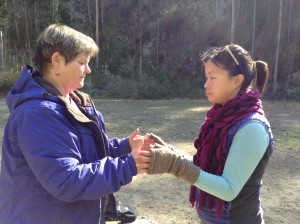
Experiment #7 was about our food being the carrier of our thoughts' energy into our bodies. Since I don't own a scale, I did this experiment by measuring how I feel in my body when I take the time to taste my food completely. If I'm talking while I eat, this is more difficult to practice. This is when I often lose track of what I'm feeling, and just keep putting food in my mouth until the plate is clean.
For those of you who would like to lose a few pounds, I'm curious what your results are after trying Pam's advice. Notice any negative thoughts you have toward your own body. Let them go and replace them with thoughts that praise your body for the way it already is. Take a moment to bring your thoughts into a state of peace, love, and joy, before you eat your food. And see what happens!
At Quarry Park, the sun continued to shine on us, and it was an unseasonably warm day.
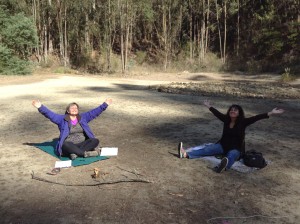
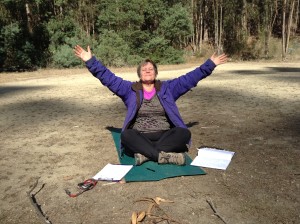
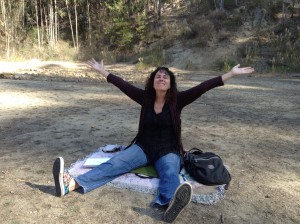
Later in the afternoon, we all attended a monthly gathering of Art and Inspiration hosted by Amy Sullivan. Tammy painted a "butterfly brain" image inspired by the E-Squared Book Club.
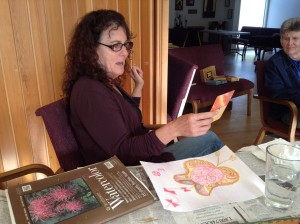
Shirley made a collage of cats and flowers and castles and circles.
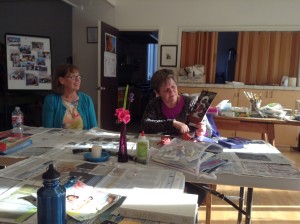
And I played with my new acrylic gel mediums. FUN! 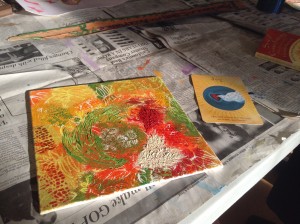 I drew the "Joy" card from the Soul Coaching deck. Its message was to remember that my soul's purpose is simple - to experience joy. And to share this and its healing qualities with the world.
I drew the "Joy" card from the Soul Coaching deck. Its message was to remember that my soul's purpose is simple - to experience joy. And to share this and its healing qualities with the world.
It has been my joy to create this book club and to experience the discoveries together in a circle.
Next week, we discuss the last two chapters, Experiments #8 and #9. In our final week, we will design our own experiments for the holiday season and end of year.
To listen to a brief (17-minute) recording from the phone meeting, click here.
As always, please feel free to share your stories in the comments!
Living With A Perfectionist In Your House
I am a recovering perfectionist. I’ve been practicing various antidotes to perfectionism quite consciously for about three years now. That makes me – the real me, the innocently imperfect me – about three years old. I’m walking, I’m talking, I’m eating with my plastic miniature utensils, insisting that I’m a big girl now. But the real big girl in the house – the house of my mind, my body, and my soul – is Miss Perfectionist. She is the one who grew up inside my house, the house of me. She became the big one without my knowing it. She got all the praise, all the money, all the polite smiling conversations at cocktail parties, all the “wow”s and “ooh”s and “aah”s, all the framed diplomas and plaques on the wall. She was surrounded by people she kept at an arm’s length distance, so they wouldn’t touch anything close to her.
She thought she liked it that way. She thought she preferred it that way, because her attention could be focused on making her hair perfect, her face perfect, her nails perfect, her shoes perfect, her outfits perfect, anything that would attract the attention of perfection praisers, which seemed to be everywhere.
Miss Perfectionist was so busy doing the things she defined as perfection – which always involved something other than the way things were – that she ignored the real me, who by the way, happened to own the house the whole time.

As I write this, I’m fresh from peeling away another layer of awareness of how Miss Perfectionist still lurks, like a creepy roommate, in the house of me. I’m also more aware of the real me, that three-year-old who has just gotten her legs, who has registered the definite feeling of walking, moving one foot in front of another, exploring this amazing thing called existence.
And I’m not willing to ignore that three-year-old, at this magical time of her life. I’m not willing to yell at her, throw her out on the porch in her nightgown, telling her she is wrong and worthless as she is. I’m not willing to have her mentored by Miss Perfectionist.
You see, Miss Perfectionist is not very supportive in moments that require vulnerability, moments that require the raw courage to step into unknown, unfelt territory. Miss Perfectionist, in fact, hates those kinds of moments. Miss Perfectionist much prefers the mind’s activity of projecting into the future, comparing the present moment to the imagined future, and listing how it doesn’t measure up: "It’s not good enough, it’s not important enough, it’s not professional enough". The list is usually much longer than three items. The list of “not”s can take over an entire conversation, an entire house, an entire life.
I see today that Miss Perfectionist is simply afraid. She is frozen with fear that someone might actually see the whole house she lives in. That there are little tiny children in there, still crawling around, learning to walk, falling down all the time in the process. That would be so humiliating to Miss Perfectionist! And she doesn’t believe she can survive that humiliation.
I see her – I see me. I see the real me beginning to live life, in the tender state of being three, being open to all possibilities and ripe with the potential of one whole life, surrendered to the present moment.
I see me, and I choose to be gentle with me. I choose to take the small steps of a three-year-old, knowing with total confidence that these steps are the only ones I – the real me - can take right now. And it’s enough.
Miss Perfectionist can have her own room in this house, but she does not own it. We are living here together, and there is space for both of us to exist in harmony. For now.
Photo credit: http://doubtfulnews.com/2012/10/buying-a-haunted-house-there-may-be-logical-reasons-why-thats-not-a-good-idea/
No Hurry, No Pause: The Rhythm of Life
*Part of a series exploring Breema's Nine Principles of Harmony
The beauty of the present moment is that there is fast forward, no rewind, no pause, no stop. Only continuous play. The continuous supply of fresh moments, unlike any other that has occurred in the past, or any that will ever occur in the future.
Even when we repeat something we think we have done in the past, we are no longer the same in that new moment. We may want to relive an old memory again and again, try to freeze it, or reproduce it by carefully recreating the conditions surrounding it in our mind’s image. But a copy is a copy, having an original life of its own in the present moment when it is experienced.
We may want to fast forward through something unpleasant, uncomfortable, or confusing, wishing that it would pass through more quickly, so that we don’t have to experience what we fear or avoid habitually. We may wish to dictate the speed of life, the pace which is appropriate for experiences to happen.
But what if we were to rest in a state of “No Hurry, No Pause” – neither dwelling on pleasantness nor fleeing from unpleasantness? What if we maintained this tempo of “No Hurry, No Pause”, as we experienced each present moment in our lives? How might we experience it differently?
How might we change our attitude toward circumstances, if we practiced “No Hurry, No Pause”, becoming a little more resilient with ourselves when it comes to what we avoid, and a little less attached to what we consider pleasurable or ideal? What might we discover at the intersection of “No Hurry" and "No Pause”?
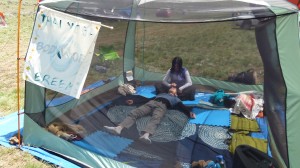
I get to experience myself at this intersection each time I do bodywork, whether it is Breema or traditional Thai massage. In that space of "No Hurry, No Pause", I find my natural rhythm, the rhythm of my body in relationship to the other body, the rhythm of being in harmony with all that is. I connect with my own body's breath, I feel the other body's breath, and somehow the breath of the universe begins to breathe us. I notice my mind sometimes wanting to hurry things along, other times checking my progress by wondering how much time is left, and even sometimes wondering if I should even try to do the next sequence. When I remember "No Hurry, No Pause" at these moments, all thoughts dissolve and my entire being becomes one with the natural rhythm that is always present....the rhythm of the music within us. The music that is always playing. No rewind, no fast forward, no pause, no stop.

